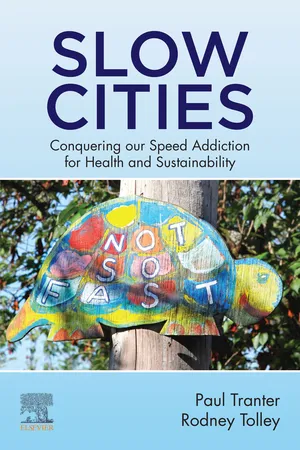
Slow Cities
Conquering our Speed Addiction for Health and Sustainability
- 422 pages
- English
- ePUB (mobile friendly)
- Available on iOS & Android
About this book
Slow Cities: Conquering Our Speed Addiction for Health and Sustainability demonstrates, counterintuitively, that reducing the speed of travel within cities saves time for residents and creates more sustainable, liveable, prosperous and healthy environments.This book examines the ways individuals and societies became dependent on transport modes that required investment in speed. Using research from multiple disciplinary perspectives, the book demonstrates ways in which human, economic and environmental health are improved with a slowing of city transport. It identifies effective methods, strategies and policies for decreasing the speed of motorised traffic and encouraging a modal shift to walking, cycling and public transport. This book also offers a holistic assessment of the impact of speed on daily behaviours and life choices, and shows how a move to slow down will - perhaps surprisingly - increase accessibility to the city services and activities that support healthy, sustainable lives and cities.- Includes cases from cities in North and South America, Europe, Asia, Africa and Australasia- Uses evidence-based research to support arguments about the benefits of slowing city transport- Adopts a broad view of health, including the health of individuals, neighbourhoods and communities as well as economic health and environmental health- Includes text boxes, diagrams and photos illustrating the slowing of transport in cities throughout the world, and a list of references including both academic sources and valuable websites
Frequently asked questions
- Essential is ideal for learners and professionals who enjoy exploring a wide range of subjects. Access the Essential Library with 800,000+ trusted titles and best-sellers across business, personal growth, and the humanities. Includes unlimited reading time and Standard Read Aloud voice.
- Complete: Perfect for advanced learners and researchers needing full, unrestricted access. Unlock 1.4M+ books across hundreds of subjects, including academic and specialized titles. The Complete Plan also includes advanced features like Premium Read Aloud and Research Assistant.
Please note we cannot support devices running on iOS 13 and Android 7 or earlier. Learn more about using the app.
Information
- Chapter 1: Introduction: changing cultures of speed
- Chapter 2: The benefits of speed for individuals: real or illusory?
- Chapter 3: The benefits of speed for economy and society: challenging the dominant narrative
- Chapter 4: The ‘slow paradox’: how speed steals our time
Introduction: changing cultures of speed
Abstract
Keywords
1.1. Introduction: a faster route to health
Table of contents
- Cover
- Title page
- Table of Contents
- Copyright
- Dedication
- Foreword
- Preface
- Part I: Speed
- Part II: Health
- Part III: Strategies
- Afterword
- Index